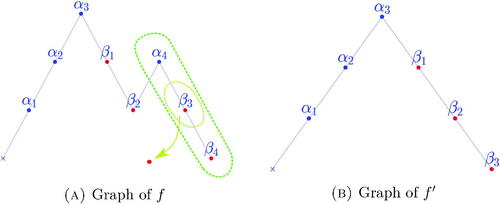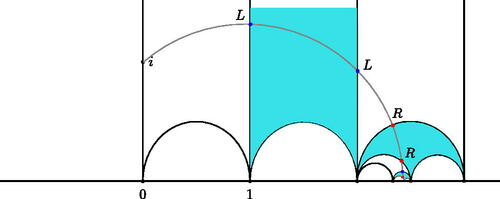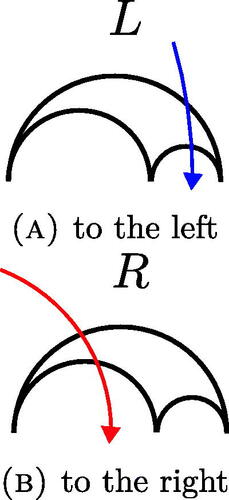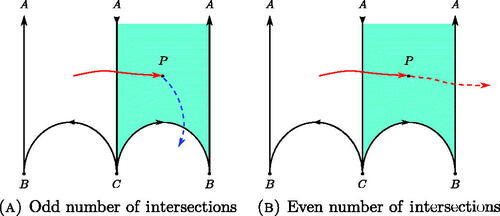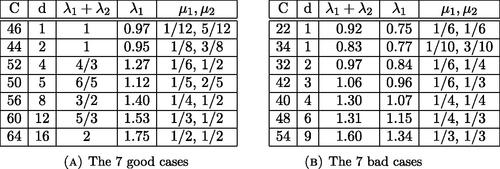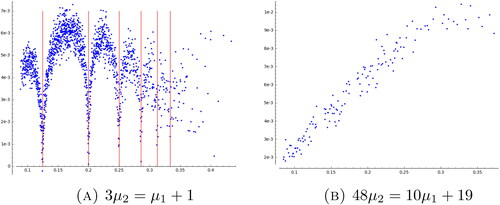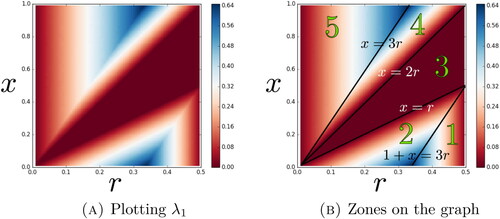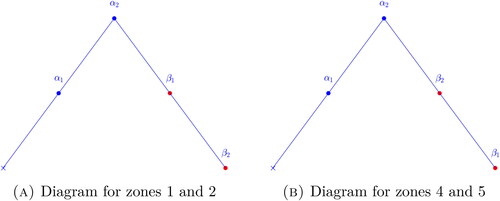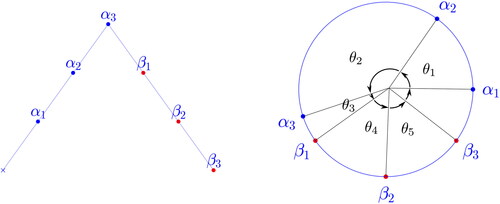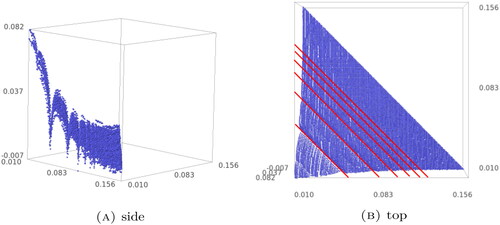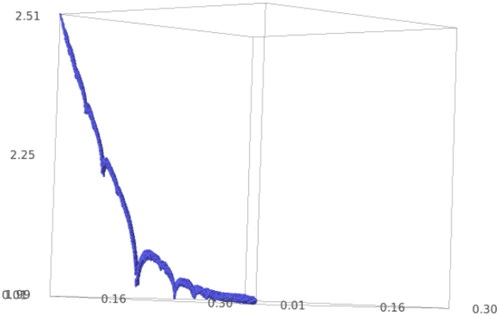 ?Mathematical formulae have been encoded as MathML and are displayed in this HTML version using MathJax in order to improve their display. Uncheck the box to turn MathJax off. This feature requires Javascript. Click on a formula to zoom.
?Mathematical formulae have been encoded as MathML and are displayed in this HTML version using MathJax in order to improve their display. Uncheck the box to turn MathJax off. This feature requires Javascript. Click on a formula to zoom.Abstract
Consider the flat bundle on corresponding to solutions of the hypergeometric differential equation
For αi and βj real numbers, this bundle is known to underlie a complex polarized variation of Hodge structure. Setting the complete hyperbolic metric on we associate n Lyapunov exponents to this bundle. We study the dependence of these exponents on parameters
through algebraic computations and numerical simulations, and point out new equality cases of the exponents with parabolic degrees of these bundles.
MATHEMATICS SUBJECT CLASSIFICATION:
1. Introduction
Oseledets decomposition of flat bundles over an ergodic dynamical system is often referred to as dynamical variation of Hodge structure. In the case of Teichmüller dynamics both Oseledets decomposition and a variation of Hodge structure (VHS) appear. Two decades ago it was observed in [Kontsevich Citation97] that these structures are linked, some of their invariants are related: the sum of the Lyapunov exponents associated to a Teichmüller curve equals the normalized degree of the Hodge bundle. This formula was studied extensively and extended to strata of abelian and quadratic differentials from then (see [Bouw and Möller Citation10, Eskin et al. Citation14, Forni et al. Citation14, Krikorian Citation03–04]). Soon this link was observed in other settings: in [Kappes and Möller Citation16] it was used as a new invariant to classify hyperbolic structures and distinguish commensurability classes of Deligne–Mostow’s non-arithmetic lattices in and
in [Filip Citation14] a similar formula was observed for higher weight variation of Hodge structures. The motivation of the present work is the study of the relationship between these two structures in a broad class of examples with arbitrary weight. The examples will be given by hypergeometric differential equations which yield a flat bundle endowed with a variation of Hodge structure over the 3-punctured sphere. A recent article [Eskin et al. Citation16] shows that the degrees of holomorphic flags of the Hodge filtration bound by below the partial sums of Lyapunov exponents. Our study will start by computing these degrees in Sections 2 and 3. After presenting an algorithm to approximate Lyapunov exponents in Section 4, we then explore the behavior of Lyapunov exponents and their distance to the latter lower bounds in Section 5. This will enable us to bring out some simple algebraic relations under which there is a conjectural equality.
1.1. Hypergeometric equations
Let and
be two disjoint sequences of n real numbers. We define the hypergeometric differential equation corresponding to those parameters
(1–1)
(1–1)
This equation originates from a large class of special functions called generalized hypergeometric functions which satisfy it. These functions have a lot of interesting properties and there is a very rich literature about them. For an introduction to the subject see for example [Yoshida Citation97].
EquationEquation (1–1)(1–1)
(1–1) is an order n differential equation with three singularities at 0, 1, and
hence its space of solutions defines locally a dimension n vector space away from singularities and can be seen in a geometric way as a flat bundle over
This flat bundle is completely described by its monodromy matrices around singularities. We will denote monodromy matrices associated to simple closed loop going counterclockwise around 0, 1, and
by M0, M1, and
We obtain a first relation between these matrices observing that composing the three loops in the same order will give a trivial loop:
The eigenvalues of M0 and
can be expressed with respect to parameters of the hypergeometric equation (Citation1–1) and M1 has a very specific form as stated in the following proposition.
Proposition 1.1.
For any two sequences of real numbers and
M0 has eigenvalues
has eigenvalues
M1 is the identity plus a matrix of rank one
Proof.
See Proposition 2.1 in [Fedorov Citation15] or alternatively Proposition 3.2 and Theorem 3.5 in [Beukers and Heckman Citation89].□
This proposition determines the conjugacy class of the representation associated to the flat bundle thanks to the rigidity of hypergeometric equations (see [Beukers and Heckman Citation89]). These classes are given explicitly in Section 4.3.
1.2. Lyapunov exponents
We now endow the 3-punctured sphere with its hyperbolic metric. As this metric yields an ergodic geodesic flow gt, to any integrable norm on the flat bundle E of dimension n we associate, using Oseledets theorem, real numbers
and a flag decomposition of E in subbundles above almost every point,
such that for any vector
where
is the flow induced by gt on E by the parallel transport for the flat connection. This is usually called the Oseledets flag decomposition. The λi are the Lyapunov exponents and correspond to the growth rate of the norm of a generic vector in each of these flags while transporting it along with the flat connection.
A complete explanation of the existence of these Lyapunov exponents in our setting can be found in [Eskin et al. Citation16]. Moreover, it is proved in Theorem 2.1 of this article that there exists a canonical family of integrable norms on the flat bundle associated to the hypergeometric equation which will produce the same flag decomposition and Lyapunov exponents. They call this family the admissible norms. In particular, the harmonic norm (see Remark in Section 2.1) induced by a VHS is admissible.
For numerical simulations, the most convenient norm to compute Lyapunov exponents is the constant norm. Consider a norm on the fiber in E over some base point in the base curve and extend it by parallel transport on a maximal simply connected subspace. The maximal domain is chosen to be the complement of a finite collection of closed path. Then this norm is not continuous across the boundaries, and depends on the choice of the domain, but define Lyapnunov exponents independently according to the following proposition.
Proposition
(2.2 in [Eskin et al. Citation16]). Any constant norm on a flat bundle in the case defined above is also integrable and computes the same Lyapunov exponents as any admissible norm.
1.3. Parabolic degree bound
Let be a dimension k holomorphic vector subbundle of the Deligne extension of E (defined in Section 2.3), we can define its parabolic degree as in Definition 2.2 that we denote by
It can be through of as a generalization of the degree of holomorphic bundles on compact complex varieties to the case were these varieties are punctured. The main theorem in [Eskin et al. Citation16] states that, in our setting,
(1–2)
(1–2)
The motivation of the present work is to explore the equality cases for this inequality. In the case of examples coming from hypergeometric equations, there are several such holomorphic vector subbundles that will be induced by an extra algebraic structure: the variation of Hodge structure.
The present work will consist, first, in computing the parabolic degrees for these induced holomorphic vector subbundles, second, to compare them with sum of Lyapunov exponents.
1.4. Variation of Hodge structure
Hypergeometric equations on the sphere are well known to be physically rigid (see [Beukers and Heckman Citation89] or [Katz Citation96]) and this rigidity together with irreducibility is enough to endow the flat bundle with a (complex) VHS (see Definition in Section 2.1) using its associated Higgs bundle structure (see [Fedorov Citation15] or directly Corollary 8.2 in [Simpson Citation90]). Using techniques from [Katz Citation96] and [Dettweiler and Sabbah Citation13], Fedorov gives in [Fedorov Citation15] an explicit way to compute the Hodge numbers for the underlying VHS. We extend this computation and give a combinatoric point of view that will be more convenient in the following to express parabolic degrees of the Hodge flag decomposition.
Let α and β be two sets of n points on the circle Starting from any of these points, we browse the circle counterclockwise (or in the increasing direction for
) and enumerate the points in
by order of appearance
Let us now define
recursively by the following properties,
We denote by f the function defined for any by
This definition depends up to a shift on the choice of starting point. For a canonical definition, we shift f such that its minimal value is 0. Which is equivalent to starting at a point of minimal value. This defines a non-negative function f that we will call the intertwining diagram of the equation ().
For every integer we define
Then we have the following theorem from [Fedorov Citation15],
Theorem
(Fedorov). The are the Hodge numbers of the VHS after an appropriate shifting.
Remark.
If the αs and βs appear in an alternate order then and
thus there is just one element in the Hodge decomposition and the polarization form is positive definite. In other words the harmonic norm is invariant with respect to the flat connection. This implies that Lyapunov exponents are zero.
In general, this Hodge structure endows the flat bundle with a pseudo-Hermitian form of signature (p, q) where p is the sum of the even Hodge numbers and q the sum of the odd ones. This gives classically the fact that the Lyapunov spectrum is symmetric with respect to 0 and that at least exponents are zero (see Appendix A in[Forni et al. Citation14]).
Pushing further methods of [Fedorov Citation15] and [Dettweiler and Sabbah Citation13], we compute the parabolic degrees of the sub Hodge bundles in the hypergeometric frame. This computation was done with the help of computer experiments in Section 5.2 which yielded a conjectural formula for these degrees. Besides from the intertwining diagram, another quantity appears. Let us relabel α and β by order of appearance after choosing α1 such that then take the representatives of α and β in
which are included in
for an arbitrary representative of α1, and define
The formula will depend on the floor value of γ. As
we have n possible values
Theorem 1.2.
Let E a flat bundle over defined by hypergeometric differential equations, and let
a Hodge decomposition for its VHS. For all
we denote by δp the degree of the Deligne compactification of
over the sphere. Then,
if
otherwise,
The proof of this theorem is given in Section 3. In Algorithm 1 we present a general way to compute δp.
1.5. Observed new phenomenon
Generalizing an example of [Eskin et al. Citation16] coming from families of Calabi–Yau varieties, we exhibit in Section 5.1 new examples which satisfy conjecturally an equality in formula (1–2) and whose monodromy groups have a particular algebraic behavior.
2. Degree of Hodge subbundles
2.1. Variation of Hodge structure
We start recalling the definition of a polarized complex variations of Hodge structures (VHS).
A VHS on a curve C consists of a complex flat bundle together with an Hermitian form h and a h-orthogonal decomposition
into
-subbundles. We write the induced flag filtrations by
and
The following conditions are satisfied:
The decreasing filtration
is holomorphic, and the increasing filtration
is anti-holomorphic.
The connection shifts the grading by at most one, i.e.
h is positive definite on
if p is even; negative definite if p is odd.
Up to a shift, we can assume that there is a n such that for i < 0 and i > n. We call n the width of the VHS.
Remark.
We can define a canonical norm by taking on spaces
, such that it is positive definite on each of these spaces. This norm is called the harmonic norm.
2.2. Decomposition of an extended holomorphic bundle
Let be a complex curve, we assume that its boundary set
is an union of points. Consider
an holomorphic bundle on
We introduce structures which will appear on such holomorphic bundle when they are obtained by canonical extension when we compactify
The first one will take the form of filtrations on each fibers above points of Δ.
Definition 2.1
(Filtration). A -filtration on a complex vector space V is a collection of real weights
for some
together with a decreasing filtration of subvector spaces
The filtration satisfies whenever
and the previous weights satisfy
for any
We denote the graded vector spaces by for ϵ small. The degree of such a filtration is by definition
This leads to the next definition,
Definition 2.2
(Parabolic structure). A parabolic structure on with respect to Δ is a couple
where
defines a
-filtration
on every fiber
for any
A parabolic bundle is a holomorphic bundle endowed with a parabolic structure. The parabolic degree of is defined to be
2.3. Deligne extension
In the following we consider a local system on
associated to a monodromy representation with eigenvalues of modulus one. We denote by
the associated holomorphic vector bundle.
We recall the construction of Deligne’s extension of which defines a holomorphic bundle on
with a logarithmic flat connection. We describe it on a small pointed disk centered at
(the full disk is denoted
). Let ρ be a ray going outward of the singularity, then we can speak of the vector space of flat sections along the ray
which has the same rank r as
As all the
are isomorphic, we choose to denote it by V0. There is a monodromy transformation
to itself obtained after continuing the solutions. This corresponds to the monodromy matrix in the given representation. For every
we define
These vector spaces are nontrivial for finitely many We define
Let be the universal cover of
Choose a basis
of V0 adapted to the generalized eigenspace decomposition
We consider
as the pull back of vi on
If
then we define
These sections are equivariant under hence they give global sections of
The Deligne extension of
is the vector bundle whose space of section over D is the
-module spanned by
This construction naturally gives a filtration on V0.
In general, we can define various extensions where j is the inclusion
is the Deligne’s meromorphic extension and
(resp.
) for
is the free
-module on which the residue of
has eigenvalues α in
(resp.
). The bundle
is a filtered vector bundle in the definition of [Eskin et al. Citation16].
If we have a VHS on
over
it induces a filtration of every
simply by taking
this is a well-defined vector bundle thanks to nilpotent orbit theorem ([Schmid Citation73] (4.9)).
In general for we define on fibers over any singularity
for
and
Definition 2.3
(Local Hodge data). For and
, we set for any singularity
also written
According to Riemann–Hilbert theorem, for any local system with all eigenvalues of the form at the singularities endowed with a trivial filtration we associate a filtered
-module with residues and jumps both equal to α (see for example synopsis of [Simpson Citation90]). Thus the sub
-module corresponding to the residue α has only one jump of full dimension at α, and
(2–3)
(2–3)
where we choose
and where
is the degree of
2.4. Acceptable metrics and metric extensions
The above Deligne extension has a geometric interpretation when we endow with an acceptable metric K. If V is a holomorphic bundle on
we define the sheaf
on
as follows. The germs of sections of
at s are the sections s(q) in
in the neighborhood of s which satisfy a growth condition; for all
there exists
such that
In general this extension is a filtered vector bundle on which we do not have much information, but the metric is called acceptable if it satisfies some extra growth condition on the curvature, and if it induces the above Deligne extensions.
Lemma 2.4
(Theorem 4 [Simpson Citation90]). The local system with non-expanding cusp monodromies has a metric which is acceptable.
Proof.
For completeness, we reproduce the construction of [Eskin et al. Citation16]. The idea is to construct locally a nice metric and to patch the local constructions together with partition of unity. The only delicate choice is for the metric around singularities. We want the basis elements of the α-eigenspace of the Deligne extension to be given the norm of order
in the local coordinate q around the cusp and to be pairwise orthogonal. Let M be such that
where T is the monodromy transformation. Then the Hermitian matrix
defines a metric such that the element
has norm
□
Corollary 2.5.
When the monodromy representation goes to identity, the parabolic degree goes to zero.
Proof.
In the proof above, it appears that implies that the matrix
and that the metric goes to the standard hermitian metric locally. The curvature goes to zero around singularities and its integral on any subbundle goes to zero. This is its analytic degree, and it is equal to the parabolic degree we are considering (Lemma 6.1 [Simpson Citation90]). □
3. Proof of Theorem 1.2
3.1. Local Hodge invariants
Our purpose in this subsection is to show the following relation on local Hodge invariants, which will imply Theorem 1.2 according to formula (2–3). The proof will be given in Section 3.2.
Theorem 3.1.
The local Hodge invariants for equation (1–1) are:
at z = 0,
at
at z = 1,
Remark.
Computations of (1–1) and (1–2) are done in [Fedorov Citation15, Theorem 3]. We give a similar proof with an alternative combinatoric point of view.
Recall that the monodromy at z = 1 has all eigenvalues but one equal to one. The last one is equal to
3.2. Computation of local Hodge invariants
In the following, we denote by M the local system defined by the hypergeometric equation (Citation1–1) in the introduction. The point at infinity plays a particular role in middle convolution, thus we apply a biholomorphism to the sphere which will send the three singularity points to
Hereafter, M will have singularities at 0, 1, 2.
Similarly corresponds to the hypergeometric equation where we remove terms in αk and βj,
Let be a flat line bundle above
with monodromy
at 0,
at 2 and
at
Similarly
is defined to have monodromy
at 0,
at 2 and
at
The two key stones in the proof are Lemma 3.1 in [Fedorov Citation15] and Theorem 3.1.2 in [Dettweiler and Sabbah Citation13]:
Lemma 3.2
(Fedorov). For any we have,
In the following theorem, we modify a little bit the formulation of [Dettweiler and Sabbah Citation13], taking so that the condition becomes
Theorem 3.3
(Dettweiler-Sabbah). Let , for every singular point in
, every
and any local system M, we have,
and,
3.2.1. Recursive argument
We apply a recursive argument on the dimension of the hypergeometric equation. Let us assume that and that Theorem 3.1 is true for n – 1.
For convenience in the demonstration, we change the indices of α and β such that αi (resp. βi) is the ith α (resp. β) we come upon while browsing the circle to construct the function f. For in
we write
if there are three real
which represent x, y, z such that x < y < z and
We apply Lemma 3.2 with αk and βj such that Let us describe what happens to the combinatorial function f after we remove these two eigenvalues. We denote by
the function we obtain ().
Removing αk will make the function decrease by one for the following eigenvalues until we meet βj, thus for any
We apply Theorem 3.3 with It yields that we have for all
at singularity zero,
which can be written in a simpler form
In terms of M and
For any integer i, j we denote by the function which is 1 when i = j and is zero otherwise.
Similarly for all at singularity 2,
And at 1, we set
If we pick for the computation, we have Hodge invariants for all values except for αn and βn. We then perform the computation for
from which we deduce the invariants at βn and αn. Yet, we should keep in mind that the previous computations are always modulo shifting of the VHS. That is why we need to have dimension at least 3, since in this case α2 will appear in both computations and will show there is no shift in our formulas.
3.2.2. Initialization for n = 2
We use the computations performed in the previous part for α2 and β2. To do so, remark that the unique (complex polarized) VHS on is defined by
and the only non-zero local Hodge invariants are
which corresponds to the definition of
for the first two, and to
for the last one.
Using the previous subsection, we deduce
According to [Fedorov Citation15], the Hodge numbers of M are
Using the fact that we can deduce the other Hodge invariants.
We conclude that and similarly
3.3. Continuity of the parabolic degree
To compute in equation (Citation2–3), we show in the following Lemma that they are locally constant on a given domain.
Lemma 3.4.
For all hypergeometric systems belonging to all distinct modulo one the δp’s only depend on the intertwining diagram and the integer part of γ.
Proof.
The main idea here is that rigidity implies that the holomorphic structure of the Higgs bundles is locally constant.
Let L and be the flat bundles of solutions of equation (Citation1–1) for eigenvalues α, β and
as in the Theorem with the same intertwining diagram and integer part of γ. We endow these flat bundles with a trivial filtration. To L and
correspond some Higgs bundle
and
together with parabolic structures at singularities (see [Simpson Citation90]).
Now consider filtered with the weights
at 0 where we take
Similarly at
and we keep the same filtration above 1. The monodromy matrices of the flat bundle associated to this new filtered Higgs bundle have the same eigenvalues as
according to the table in the Synopsis of [Simpson Citation90] (p. 720) and no nilpotent part. Thus its monodromy matrices are conjugate locally with the ones of
and by rigidity is isomorphic to
We conclude using uniqueness of system of Hodge bundle associated to a stable rigid Higgs bundle with given weights. □
Together with Corollary 2.5 it will be enough to compute We fix an intertwining diagram and a floor value for γ and make the α and βs go to 0 or 1. At the limit, the parabolic degree is zero and we can deduce
from the Theorem 3.1 as described in the next subsection.
3.4. Algorithm to compute δp
Computation of δp
function degree()
if then return 0
else if LENGTH then
if p > 1 then return 0
else return –1
end if
end if
relabel
for do
if and
then
end if
if and
then
end if
end for
if then
if then
end if
else
if then
end if
end if
if then
end if
return
end function
Using the previous lemma, we present an algorithm to compute δp for a given set of α and β. We let the monodromy matrices go to identity while keeping the intertwining diagram and γ unchanged. Corollary 2.5 states that the parabolic degree at the limit will be zero, thus we can deduce δp from the formula for the corresponding parabolic degree at the limit.
Assume is a minimal value of
then γ is computed for representatives of the α and β in the interval
for any representative of α1 in
We shift everything so that we can assume
— this process of relabeling and shifting is done by the function Relabel in Algorithm 1.
Remark that we can deform the set of points continuously such that two consecutive α and β get infinitely close from one another without changing the quantity γ, their value do not interfere any further in the degree formula. Indeed, as they are consecutive points, they will always appear substracted one to the other in the formulas, we can thus shift them together freely without changing neither the intertwining diagram, the value of γ, nor the parabolic degrees. We can then concentrate on the remaining points.
This implies an induction process on the dimension of the bundle to compute δp. Consider the gaps between two consecutive points that are not both α or both β. Let αi and βj be the two points with a minimal such gap—this is returned by the function Smallest in Algorithm 1. If αi comes before βj in the cyclic order, pick another βk such that the next point is some α, and shift simultaneously αi and βk by We make a symmetric process in the opposite case. This reduces the problem to one dimension lower, without αi and βj.
In the case when we let βj go to α1, the quantity
Otherwise,
This is why we add the variable c to the recursive result in the algorithm when these two points appear in the formula of the parabolic degree, i.e. when
Finally, in some cases the intertwining diagram on the induced set of α and β will be shift by one, compared to the initial one. This is why we need to compare the minimum of the function f one the new set of points, and modify the value of p accordingly.
4. Algorithm
In this section, we describe the algorithm used to compute the Lyapunov exponents. We start by simulating a generic hyperbolic geodesic and following how it winds around the surface, namely the evolution of the homology class of the closed path. Finally we compute the corresponding monodromy matrix after each turn around a cusp.
4.1. Hyperbolic geodesics
The first question that arise when trying to compute Lyapunov exponents is how to simulate a generic hyperbolic geodesic. We find an answer in a beautiful theorem proved by Caroline Series in [Series Citation85] which relates hyperbolic geodesics on the Poincaré half-plane and continued fraction development of real numbers. We follow here the notations of [Dal’Bo Citation07] (see part II.4.1).
Let us consider the Farey tessellation of (see ). It is invariant with respect to the discrete subgroup of index 3 in
generated by
The tessellation yields fundamental domains for the action of this group. The sphere minus three points endowed with its complete hyperbolic metric is a degree two cover of the surface induced by the quotient of by this group. This is why we represent the tessellation with two colors: a fundamental domain for the sphere is given by any two adjacent triangles of different colors. Thus it will be easy once we understand the geodesics with respect to this tessellation to see them on the sphere.
Let us consider a geodesic going through i. It lands on the real axis at a positive and a negative real number. The positive real number will be called x, this number determines completely the geodesic since we know two distinct points on it.
We associate to this geodesic a sequence of positive integers: consider the sequence of hyperbolic triangles the geodesic crosses. For each one of those triangles, the geodesic has two ways to cross them (see ). Once it enters it, it can leave it crossing either the side of the triangle to its left (a) or to its right (b).
Remark.
The vertices of hyperbolic triangles are located at rational numbers, so this sequence will be infinite if and only if x is irrational (see [Dal’Bo Citation07] Lemme 4.2).
We have now for a generic geodesic an infinite word in two letters L and R associated to a geodesic. For example the word associated to the geodesic in , is of the form We can factorize each of these words and get
Except for n0 which can be zero the ni are positive integers.
Theorem 4.1.
The sequence is the continued fraction development of x. In other words,
The measure induced on the real axis by the measure on dominates Lebesgue measure.
See [Dal’Bo Citation07] II.4 or [Series Citation85] for a proof.
Remark.
This theorem states exactly that to study a generic geodesic on the hyperbolic plane, we can consider a Lebesgue generic number in and compute its continued fraction development.
As explained in the introduction, we consider the Lyapunov exponents induced by the flat connection on the hypergeometric functions bundle. They are defined for almost every points in the unit tangent bundle of the base space (here ) as the growth of transported vectors along the hyperbolic geodesic flow. Thus to compute these Lyapunov exponents, we need to estimate the parallel transport induced by the flat connection along the hyperbolic flow. So we need to understand how a generic hyperbolic geodesic winds around the cusps, and compute the product of the corresponding monodromy matrices for the flat connection. By the previous theorem we can simulate a generic cutting sequence of a hyperbolic geodesic in the Farey’s tessellation of
Our goal now will be to associate to such a sequence a product of monodromy matrices keeping track of its homotopy class.
There is a representation of the hyperbolic structure on given by two ideal triangles in the hyperbolic half-plane
and
glued together as in . The three cups of this representation are denoted by A, B, and C. They can be permuted by an isometry which preserves or reverses orientation whenever the permutation preserves or changes the cyclic order of the cups. This representation is constructed with two copies of a fundamental domain for Farey’s tessellation, thus the cutting sequence of a generic geodesic against these two cells is encoded as previously by the continued fraction expansion of a generic real number.
In this representation, let P be a point inside the triangle Let us assume the first side crossed by the geodesic in
and the next number in the coding N describes how many times the geodesic will cross the left sides of the triangle after the first crossing. Observe that after one crossing we are back to P and the geodesic made a loop in the direct (counter-clockwise) direction around the cusp A. Each pair of crossing to the left adds one loop around A. At the end of this sequence of crossings we must discriminate two cases:
If N is even, the geodesic makes
direct loops around A, and the next crossing will be along
If N is odd, the geodesic makes
direct loops around A. The next crossing is given by one unit of the next number of crossings to the right and will be along (0, 1).
The remaining part of the trajectory of the geodesic is now described by the next numbers of the coding. The one following N, now describes how many times the geodesic crosses the right side of the triangles. We now apply an orientation reversing isometry (such that left and right will be switched) on the representation to reduce the problem to the previous case, where the geodesic starts by crossing the geodesic
and the number N describes how many times it will cross the left side ().
In the first case, we invert 1 and
(A and B), and
In the second case, we invert 0 and
(C and A), and
There is a last point to consider, since we want to compare the growth of the norm with regards to the geodesic flow, we need to follow the length of the latter. Here we have a discretized description of the geodesic flow, at each time it returns to the fundamental domain. We can with this description fully describe the homology of the flow, but its length will a priori not correspond to the number of iterations of our algorithm. Its speed is given by the first Lyapunov exponent of the Gauss map, as explained in [Zorich Citation96] Appendix 10. It is equal to Lévy’s constant
4.2. Pseudo-code
Based on the previous subsection, we now formulate in Algorithm Citation2 the pseudo-code of an algorithm to computing the Lyapunov exponents of a local system over for given monodromy matrices at cusps.
Let us start with a random vector () in the local system and follow its parallel transport along a random hyperbolic geodesic. This random geodesic is coded by a random number in the interval
with respect to the invariant Gauss measure (
). Namely, it is coded by the continued fraction development
As explained in the previous subsection, we start in a ideal triangle in the fundamental domain, and mark the cusp at the top with the variable
The geodesic
will be the first one to be crossed by the cutting sequence.
The orientation alternates after each step, so it will be read out of the parity of i. Moreover, when the number of cuttings determined by xi is odd, we use one cutting from the next sequence to reduce to the previous case. We keep track of this phenomenon with a penalty variable p.
The key point of the algorithm is to keep track of which cusp is placed at in the given representation. The other two cups will be determined by the orientation, that is why we use maps next and previous which browse through this cyclic ordering of the cusps fixed at the beginning, here
Simulation of hyperbolic flow
⊳
for do
if N is even and i is odd then
end if
if N is even and i is even then
end if
if N is odd and i is odd then
end if
if N is odd and i is even then
end if
end for
We apply this algorithm to n random vectors v, after a large number of iterations K we orthogonalize the family of vectors using Gram–Schmidt process. Let the norms of these orthogonal vectors. Then the Lyapunov exponents λi can be estimated with the formula
4.3. Monodromy matrices
In the introduction, Proposition 1.1 gives a set of properties on the monodromy matrices for hypergeometric differential equations with two distinct sequences of real parameters. The following theorem of Levelt (see Theorem 3.2.3 in [Beukers Citation09] for a proof) gives a rigidity property for these matrices together with a very useful specific form for them.
Theorem 4.2
(Levelt). Assume and
are two disjoint sequences. Then
is a reflection and the pair
is uniquely determined up to conjugation by
With
5. Observations
5.1. Calabi–Yau families example
A first family of examples is coming from 14 1-dimensional families of Calabi–Yau varieties of dimension 3. The Gauss–Manin connection for this family on its Hodge bundle gives an example of the hypergeometric family we are considering. The monodromy matrices were computed explicitly in [Van Enckevort and Van Straten Citation08] and are parametrized by two integers C and d. We introduce the following monodromy matrices,
In the previous notations, These matrices satisfy relation
We see that
has rank one and eigenvalues of M0 and
have modulus one thus correspond to hypergeometric equations. In this setting, T has eigenvalues all equal to one and eigenvalues of
are symmetric with respect to zero, we denote them by
where
The parabolic degree of the holomorphic Hodge subbundles are given by,
Theorem
[Eskin et al. Citation16]. Suppose then the degree of the Hodge bundles are
Thus according to the same article, we know that is a lower bound for the sum of Lyapunov exponents. We call good cases the equality cases and bad cases the cases where there is strict inequality.
There are 14 different couples of values for C and d where the corresponding flat bundle is an actual Hodge bundle over a family of Calabi–Yau varieties. These examples where computed few years ago by M. Kontsevich and were a motivation for this article. We list them in .
Figure 9. Difference between sum of Lyapunov exponents and parabolic degree for a generalization of the 14 families in [Eskin et al. Citation16].
![Figure 9. Difference between sum of Lyapunov exponents and parabolic degree for a generalization of the 14 families in [Eskin et al. Citation16].](/cms/asset/d71f7dae-b01b-462b-93a2-70914bb089ef/uexm_a_1580632_f0009_c.jpg)
To see what happens in a similar setting for more general hypergeometric equations, we vary C, d and compute the corresponding eigenvalues μ1 and μ2 as well as the Lyapunov exponents. In we drew a blue point at coordinate if the sum of positive Lyapunov exponents are as close to the parabolic degree
as the precision we have numerically and we put a red point when this value is outside of the confidence interval.
Note that according to it seems that all points below the line of equation are bad cases. In , we represent the distance of the sum of the Lyapunov exponents to the expected formula. We see that this gives a function that oscillates above zero. More precisely, it seems that good cases are outside of some lines passing through
To push the numerical simulations further, we consider what happens on lines of equation () and
() both passing through
and a point corresponding to one of the previous good cases.
We observe that on the graph () there is only one good case which corresponds to in the previous list of good cases. In the graph (), there are good cases at points
which were also on the previous list but other points appear such as
Remark that these all have the form
we checked it numerically for all
we conjecture that this phenomenon appears for every
According to [Brav and Thomas Citation14] and [Singh and Venkataramana Citation14], the 7 good cases correspond to cases where the monodromy group of the hypergeometric local system is of infinite index in which is commonly called thin. In the other cases the group is of finite index and is called thick. The new conjectural good cases we found by ways of Lyapunov exponents do not seem to have a representation with integers or even rational C and d. A lot of questions arise about these points, for example can we find a number-theoretic interpretation of their equality as in Conjecture 6.5 in [Eskin et al. Citation16], or is there a specific property on the monodromy group in these cases.
Yuri Manin pointed out a possible interpretation in cosmology of the Lyapunov exponents in our setting, and a probable relation to Kasner exponents using time complexification; compare to [Manin and Marcolli Citation14] and [Manin and Marcolli Citation15].
5.2. Examples for n = 2
As we have seen in the introduction the two Lyapunov exponents are symmetric λ1 and The sum of the positive Lyapunov exponents is just λ1. The parameter space we have for these 2-dimensional flat bundles are
The Lyapunov exponents are invariant through translation of the set of parameters. Indeed, we can consider the bundle with and
monodromies, it will have the same set of Lyapunov exponents since both scalar will appear with the same frequency and its parameters will be
hence without loss of generality we can assume
Moreover the parameters are given as a set, the order does not matter.
In the following experiments we will consider a set of parameters where the βs will be equidistributed and the αs will be shifted with respect to them. Here we represent the value of the Lyapunov exponent for and we have by definition
().
Remark.
We first notice that the zone where the Lyapunov exponent is zero corresponds to the setting where the parameters are alternate and where there is a positive definite bilinear form invariant by the flat connection (see Section 1). This will be true whenever the VHS has weight 0.
Another noticeable fact is that zones are delimited by combinatorics of α and β, and of introduced in the introduction.
Remark that is 0 in zones 1, 4, and 1 in zones 2, 5. In the following table, we give a relation binding
obtained by linear regression. The other column is the formula for the parabolic degree in the given zone ().
In this case, the VHS is of weight and thus is in the setting of [Kontsevich Citation97]. In consequence, we have the equality
where
is the parabolic degree of the holomorphic bundle and
the Euler characteristic of S.
This is a good test for our algorithm and formula on degree. More generally, for any dimension n, this formula will hold as long as the weight is equal to 1.
5.3. A peep to weight 2
Let n be equal to 3. In this case, there will be three Lyapunov exponents As explained in the previous subsection, if the weight of the VHS is 0,
if it is 1, λ1 is equal to twice the parabolic degree of
We consider configurations where the weight is 2. Assume
the only cyclic order in which the VHS is irreducible and of weight 2 is for,
We parametrize these configurations with 5 parameters which will correspond to the distance between two consecutive eigenvalues: ().
Using a Monte-Carlo process, we found some values in this configuration for which there is equality with twice the parabolic degree of We remarked that several parameter points where there is equality satisfy
and
This motivated us to consider the 2 dimensional subspace of parameters
For these parameters we can observe a remarkable phenomenon; the difference between the Lyapunov exponent and the formula with parabolic degrees depends only on x + y. We plot this difference in and see that for some values of x + y there is equality.
We computed that for the formula holds.
Remark that
Yet
and
Hence
There is equality when
Moreover in the three previous cases.
We try now another family with an irrational parameter,
Again we observe that the difference between the Lyapunov exponent and the formula with parabolic degrees depends only on x + y ().
We observe that the difference goes to zero at which does not seems to be rational as before. Moreover, in this case,
and
and
Acknowledgments
These experiments were suggested by Maxim Kontsevich, I am very grateful to him for suggesting this problem, sharing his initial experiments, and for his involvement. I thank dearly Jeremy Daniel for his curiosity to the subject and his answer to my myriad of questions as well as Bertrand Deroin; Anton Zorich for his flawless support and attention, Martin Müller and Roman Fedorov for taking time to explain their understanding of the parabolic degrees and Hodge invariants at MPIM in Bonn. I am also very thankful to Carlos Simpson for his kind answers and encouragements, and to Yuri Manin for pointing out a possible link to cosmology.
References
- [Beukers 09] F. Beukers. Notes on Differential Equations and Hypergeometric Functions, 2009.
- [Beukers and Heckman 89] F. Beukers and G. Heckman. “Monodromy for the Hypergeometric Function nFn−1.” Invent. Math. 95:2 (1989), 325–354.
- [Bouw and Möller 10] I. I. Bouw and M. Möller. “Teichmüller Curves, Triangle Groups, and Lyapunov Exponents.” Ann. Math. (2) 172:1 (2010), 139–185.
- [Brav and Thomas 14] C. Brav and H. Thomas. “Thin Monodromy in Sp(4).” Compos. Math. 150:3 (2014), 333–343.
- [Dal’Bo 07] F. Dal’Bo. Trajectoires géodésiques et horocycliques. Savoirs Actuels (Les Ulis). [Current Scholarship (Les Ulis)]. Les Ulis/Paris: EDP Sciences/CNRS Éditions, 2007.
- [Dettweiler and Sabbah 13] M. Dettweiler and C. Sabbah. “Hodge Theory of the Middle Convolution.” Publ. Res. Inst. Math. Sci. 49:4 (2013), 761–800.
- [Eskin et al. 16] A. Eskin, M. Kontsevich, M. Moeller, and A. Zorich. “Lower Bounds for Lyapunov Exponents of Flat Bundles on Curves.” Preprint, arXiv:1609.01170, 2016.
- [Eskin et al. 14] A. Eskin, M. Kontsevich, and A. Zorich. “Sum of Lyapunov Exponents of the Hodge Bundle with Respect to the Teichmüller Geodesic Flow.” Publ. Math. Inst. Hautes Études Sci. 120 (2014), 207–333.
- [Fedorov 15] R. Fedorov. Variations of Hodge Structures for Hypergeometric Differential Operators and Parabolic Higgs Bundles, 2015.
- [Filip 14] S. Filip. “Families of K3 Surfaces and Lyapunov Exponents.” Preprint, arXiv:1412.1779, 2014.
- [Forni et al. 14] G. Forni, C. Matheus, and A. Zorich. “Zero Lyapunov Exponents of the Hodge Bundle.” Comment. Math. Helv. 89:2 (2014), 489–535.
- [Kappes and Möller 16] A. Kappes and M. Möller. “Lyapunov Spectrum of Ball Quotients with Applications to Commensurability Questions.” Duke Math. J. 165:1 (2016), 1–66.
- [Katz 96] N. M. Katz. Rigid Local Systems, Annals of Mathematics Studies, Vol. 139. Princeton, NJ: Princeton University Press, 1996.
- [Kontsevich 97] M. Kontsevich. “Lyapunov Exponents and Hodge Theory.” In The Mathematical Beauty of Physics (Saclay, 1996), Adv. Ser. Math. Phys., Vol. 24, pp. 318–332. River Edge, NJ: World Sci. Publ., 1997.
- [Krikorian 03–04] R. Krikorian. “Déviations de moyennes ergodiques, flots de teichmüller et cocycle de kontsevich-zorich.” Séminaire Bourbaki 46 (2003–2004), 59–94.
- [Manin and Marcolli 14] Y. I. Manin and M. Marcolli. “Big Bang, Blowup, and Modular Curves: Algebraic Geometry in Cosmology.” Preprint, arXiv:1402.2158, 2014.
- [Manin and Marcolli 15] Y. Manin and M. Marcolli. “Symbolic Dynamics, Modular Curves, and Bianchi IX Cosmologies.” Preprint, arXiv:1504.04005, 2015.
- [Schmid 73] W. Schmid. “Variation of Hodge Structure: The Singularities of the Period Mapping.” Invent. Math. 22 (1973), 211–319.
- [Series 85] C. Series. “The Modular Surface and Continued Fractions.” J. Lond. Math. Soc. (2), 31:1 (1985), 69–80.
- [Simpson 90] C. T. Simpson. “Harmonic Bundles on Noncompact Curves.” J. Amer. Math. Soc. 3:3 (1990), 713–770.
- [Singh and Venkataramana 14] S. Singh and T. N. Venkataramana. “Arithmeticity of Certain Symplectic Hypergeometric Groups.” Duke Math. J. 163:3 (2014), 591–617.
- [Van Enckevort and Van Straten 08] C. Van Enckevort and D. Van Straten. “Monodromy Calculations of Fourth Order Equations of Calabi–Yau Type.” In “Mirror Symmetry V”, the BIRS Proc. on Calabi–Yau Varieties and Mirror Symmetry, AMS/IP, 2008.
- [Yoshida 97] M. Yoshida. Hypergeometric Functions, My Love. Aspects of Mathematics, E32. Friedr. Braunschweig: Vieweg & Sohn, 1997. Modular interpretations of configuration spaces.
- [Zorich 96] A. Zorich. “Finite Gauss Measure on the Space of Interval Exchange Transformations. Lyapunov Exponents.” Ann. Inst. Fourier (Grenoble) 46:2 (1996), 325–370.

